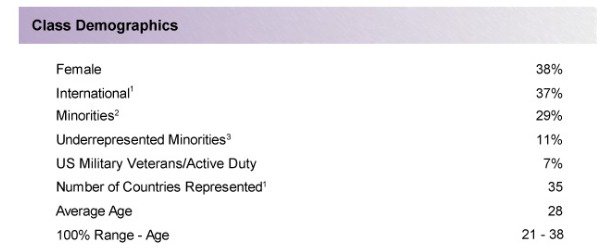Female Enrollment, GMAT Scores Rise for NYU Stern Class of 2019

Applications are up and acceptance rates are down, according to new statistics from the New York University Stern School of Business Class of 2019.
A total of 3,927 applicants applied to join the NYU Stern Class of 2019, increasing around 4 percent from last year’s figure of 3,773. Despite the growing pool of applications, enrollment actually got tighter, dropping from 871 admissions last year to 822 for the Class of 2019.
From the 822 admitted students, a total of 402 elected to join the NYU Stern Class of 2019—up slightly from the 392 enrolled students in the Class of 2018. While the difference in the number of incoming students is minimal, the demographics that make up those students, however, differ from last year’s figures. The percentage of incoming students who are female jumped modestly from 35 percent to 38 percent. The percentage of admitted international students also slightly increased, moving up from 35 percent to 37 percent for the Class of 2019, representing 35 countries overall.
The average GPA for NYU Stern Class of 2019 slipped from 3.51 to 3.48, but GMAT scores actually drifted upwards, improving from an average score of 710 for the Class of 2018 to 714. The median GMAT score, however, saw a larger increase, moving up to 720 from 710 last year.
A slight majority of incoming Stern School of Business students join with previous experience in the financial services industry, totaling 29 percent. Following in second is consulting, with roughly 12 percent, followed by students with government and/or military backgrounds at 7 percent. Stern has been fairly active in recruiting applicants with military backgrounds and aspirations, implementing the Fertitta Veterans Program less than a year ago. The program will assist 20 full-time MBA students with military experience drastically reduce tuition yearly tuition fees, falling to a flat rate of $30,000 per year.
For more information regarding the NYU Stern School of Business Class of 2019, MBA program details, scholarships and more, please visit the school website.
This article has been edited and republished with permissions from Clear Admit.
New NYU Stern Memory Study Says Put Away the Camera

The Stern School of Business at New York University recently explored the new research that explores how photographs might reinforce visual memory at the expense of non-visual memory.
NYU Stern Launches New Tech and Fashion & Luxury MBAs

INSEAD, watch out. New York University Stern School of Business is getting into the one-year MBA game—and leveraging its New York City location in a major way. Stern announced yesterday that it will launch two new May-to-May MBA programs, one in tech and a second in fashion and luxury. In just 12 months, students in these programs will complete a foundational business core, a specialty area core, and electives. Along the way, they will work on real-life business projects for companies in tech or fashion and luxury respectively, gaining the experience and building the relationships that will land them jobs when they’re done.
Continue reading…
The Best Part-Time New York City MBA Programs

Not everyone can afford to quit their job to go back to school full time for an MBA. Thankfully, you don’t have to. If you live in New York City, there are over half a dozen part-time MBA programs for you to choose from, but with such a large list it can be difficult to choose the best program for you.
That’s why we’ve outlined the best part-time New York City MBA programs to help you out. Each of these programs offers something that helps it stand out from the rest. Continue reading…
Financing Your MBA, Part 2

In the first of our multi-part series on financing your MBA, we took a look last week at the costs involved in attending a top-tier business school. Now, with a better handle on how much money you’ll need, let’s start looking at where that funding will come from.
Students typically rely on a mixture of savings, fellowships and scholarships, employer or outside assistance, and loans to meet the cost of an MBA program. According to the GMAC 2016 Prospective Student Survey, prospective students expect to finance almost half their education through a combination of grants, fellowships and scholarships (26 percent) and loans (20 percent). Other anticipated sources of aid include personal savings, parental support, employer support and spousal or partner earnings.
Meanwhile, estimates from several top programs suggest that between 30 and 50 percent of students receive some form of fellowship or scholarship. For instance, the Stanford Graduate School of Business calculates that 50 percent of its students receive fellowships funds, while New York University’s Stern School of Business states that up to 20 percent of its full-time MBA students receive merit-based scholarships. Harvard Business School (HBS), one of the few schools to solely offer need-based aid, reports that 50 percent of students are eligible for needs-based Fellowships. About half of all HBS students receive approximately $37,000 each year through need-based fellowships, the school says.
The best place to find information about a particular program’s financial aid offerings is the business school’s financial aid office, which may be run by the parent university. Along with providing substantial information about school-based fellowships or scholarships, financial aid officers can also help students navigate the loan application process and secure alternative sources of funding. In addition, free online resources such as finaid.org, scholarships.com or Peterson’s Award Database can provide students with further guidance in financing their degrees.
School-Based Financial Aid
Schools often offer a variety of options to help students pay for their education. These options can include merit- or need-based business school scholarships or fellowships, university-wide scholarships, work-based opportunities such as research assistant or teaching assistant positions, and lists of outside resources. To find out more about a particular school’s offerings, students should refer to the financial aid or cost of attendance section of a school’s website or contact the school’s financial aid office directly.
Merit-and Diversity-Based Fellowships and Scholarships
Most scholarships provided by schools are awarded based on merit, meaning they are offered to students who have demonstrated qualities such as academic excellence, professional aptitude or outstanding leadership. Merit-based scholarships are usually awarded at the admissions committee’s discretion in order to attract the highest caliber students and can cover the full cost of tuition.
To enhance the diversity of a class, private donors, alumni and corporations also can endow a variety of scholarships or fellowships targeted towards applicants with a particular career interest, educational background, nationality, racial or ethnic identity, or gender. In addition, some schools offer financial awards to students who are already enrolled and have demonstrated leadership on campus or exceptional academic ability.
The process of applying for scholarships and fellowships varies by school. In some cases, students are automatically considered for these awards when they submit their applications to an MBA program, with no additional work required. Alternatively, some scholarships and fellowships require an additional essay, submitted either at the time of application to the program or after acceptance. A large majority of merit- and diversity-based awards are time-sensitive or based on a first-come, first-served process, so students are encouraged to apply early in the MBA admissions cycle.
Scholarships provided directly by a school are typically offered on a consistent basis year to year. However, endowed fellowships or private scholarships may not always have funds available. Students applying separately to these scholarships and fellowships should check with the head of each program to ensure they are being offered that year.
Need-Based Awards
Though not as widely available, schools may offer financial aid based on students’ demonstrated financial needs. Certain leading schools, such as Harvard, are notable exceptions to this trend in that all of the fellowships they offer are based on financial need. Need-based aid may come in the form of a grant, which does not need to be paid back, or a low-interest loan.
When deciding whether to offer a student need-based aid, the financial aid office typically weighs the student’s income from previous years; his or her spouse’s financial situation; any assets such as stocks, trust funds or home equity; and other outside funding such as employer assistance. Schools compile this information by either asking students to fill out school-specific forms or, in the case of U.S. citizens and permanent residents, using information found in the Free Application for Federal Student Aid, more commonly known as the FAFSA.
School-Based Work Opportunities
MBA programs typically discourage full-time students from working during their studies. However, some business schools, like Stern, do offer work-based financial assistance, in which students apply to work with professors on research projects or help teach classes in exchange for tuition reimbursements. These opportunities may pay up to $20,000 a year and are usually available after a student has been enrolled for at least a semester.
Loan Repayment Assistance Programs
Loan Repayment Assistance Programs (LRAPs) are designed to encourage students to pursue careers in the public and nonprofit sectors, which generally offer lower salaries than those in the private sector, by offering assistance on loan repayments. While the individual requirements of each program vary by school, LRAPs typically require that a graduate work full-time, receive an income below a certain threshold and demonstrate they required financial aid during their MBA studies. Financial support from these programs varies from covering a certain percentage of a student’s loan to assuming the full cost of a loan payment.
Next up in the series, we’ll provide an overview of private scholarships, as well as public and private loan programs. In subsequent posts we’ll examine options for international students, specific financial aid programs at individual schools and more. So stay tuned.
This article has been edited and republished with permissions from Clear Admit.
Financing Your MBA, Part I

As more and more of you are receiving your admissions results from all your hard work during the MBA application process, we wanted to turn our attention to how you’ll manage financing your MBA.
If you’ve got a spare couple hundred thousand dollars in your bank account, then you can probably skip this series. For everyone else, read on. In this post and a handful to follow, we’ll provide a broad overview of the various costs a typical MBA student faces and the types of funding opportunities currently available. Down the line, we’ll take a closer look at the financial aid processes at a diverse range of leading business schools, giving you the tools you need to assess MBA programs in light of both your own goals and available financing options.
If you’re just beginning to think about an MBA, this series can help map out the landscape, outlining the financial aid process and resources available at various programs. You can extend your research by consulting the Clear Admit School Guides and schools’ own websites, as well as through conversations with current students.
First Things First: What’s an MBA Going to Cost?
The first step in financing the MBA is getting a handle on how much it will cost. The primary expense of an MBA program is tuition. Having said that, there are a variety of other costs—including living expenses, course materials and additional fees—that can increase the total amount a student pays by a half again. Most business schools provide a breakdown of the expenses, which are posted under the financial aid or admissions section of their websites in order to help prospective students seriously consider the cost of completing a particular MBA program. Schools typically take the total cost of attendance into account when calculating the financial aid package students receive.
Tuition
Tuition at the top business programs has risen steadily for decades, often at a rate above inflation. Students can now expect to pay between $50,000 and $75,000 for a single year’s tuition at a top school, with an average total price tag of $130,000 for tuition alone. Public universities, which discount tuition for state residents, can sometimes be more affordable. For instance, in-state residents attending schools such as UT Austin’s McCombs and UNC’s Kenan-Flagler pay about $15,000 less in tuition each year than do out-of-state residents. The range of variance of costs that in-state residents pay can be explained in part by the different levels of subsidies that public universities receive and the economies of the states in which they are located.
Living Costs
The cost of living also forms a substantial part of a student’s expenses while at business school. These costs typically cover housing, food, utilities and other personal expenses, and they can vary widely by geographic region. For example, the Fuqua School of Business, located in the college town of Durham, North Carolina, estimates that students will pay $12,800 for room and board in their first year. Meanwhile, at NYU Stern, located in the center of Manhattan in New York City, the estimated cost for room and board is $25,170.
Living costs are usually based on surveys of the student population or estimates of local rental costs. Students should keep in mind that the figures posted by most schools are for single students with no dependents; those with partners or children should take into account the additional expenses of balancing family life with full-time studies. Harvard Business School, for instance, estimates that students with a spouse or partner should set aside an additional $16,900 in yearly expenses for a spouse or partner, another $13,100 for one child and an additional $8,500 for a second child. Meanwhile, Tuck, with its rural New Hampshire campus, calculates that $7,500 should be set aside for each additional family member. Prospective students with further questions may contact their target programs’ financial aid offices in order to request information about expected family expenses.
Additional Expenses and Fees
Course materials, healthcare insurance, transportation costs and other mandatory university fees can add several thousand dollars to a student’s expenses each year. For example, Wharton’s Pre-term fee is $2,000. Furthermore, extracurricular activities, particularly international trips that are often a highlight of an MBA experience, can substantially increase costs; for example, the Kellogg Worldwide Experience and Service Trips (KWEST) run into the thousands before considering a number of additional out-of-pocket expenses. To help cover these expenses, some schools allow students to apply for an increase to their cost of attendance and thereby take on more loans.
Loan Interest
Because recent legislature has rendered federally subsidized loans unavailable for U.S. citizens or permanent residents in graduate school, students relying on loans to fund their studies will see their interest accumulate while in business school. For the most part, students do not have to start paying that interest, or the principle, until several months after they graduate. Federal loans and some private loans also include an ordination fee that is tacked on to each loan disbursement. We’ll go into greater detail on loans in a later post in this series.
Stay tuned for future posts in this series, where we’ll take a closer look at the range of financing options available to MBA students—including school-based financial aid, private scholarships and loan programs—as well as specific resources for international students.



